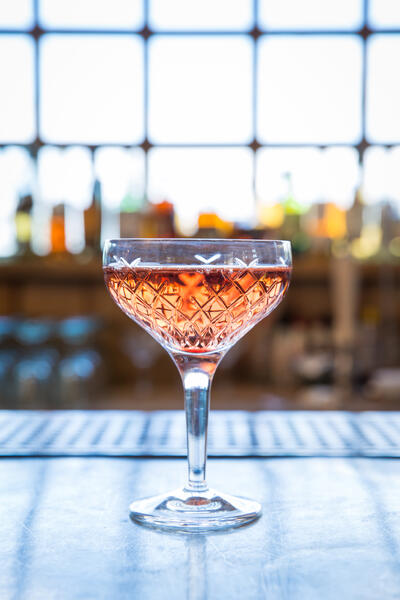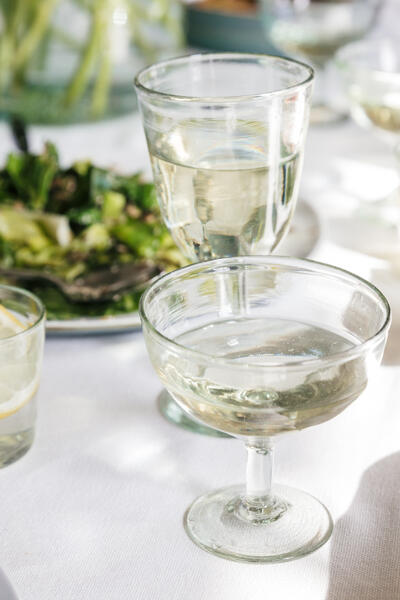If you know nothing about wine, apart from the fact you like drinking it, may we introduce our Master Sommelier, Vincent Gasnier. Vincent selects all the wines that make it into our Houses, as well as training staff so they can help you choose the perfect wine. We asked him to demystify a few wine-related matters, such as decanting, the age-old Champagne versus Prosecco dilemma, and how to navigate a wine list like a pro. He also shares his personal favourites, some future classics and the wine he was drinking on a very special day.
Vincent Gasnier, Soho House Master SommelierI came to England in 1996 to work at the Hotel Du Vin in Winchester. I set up my company to manage private cellars – then Nick [Jones] asked me to join the team in 2001 and I’ve been with Soho House ever since. In my four years at Hotel Du Vin, I won Ruinart’s best UK Sommelier in 1997 and became the youngest master sommelier in the world aged 22. I have published six books and regularly do TV appearances, as well as judging competitions for magazines such as the Decanter Wine Awards. Training is a big part of my work. We run wine schools and I tutor WSET – a world-famous exam that you can carry all round the globe, which Soho House provides free for staff. One of my greatest assets is to be able to find good wines at any budget, so we can offer value for money to our members.

'I love exploring new wines, but in my heart I love great classic reds from Bordeaux. I did a members' event at Soho House 76 Dean Street on Spanish wines, on undiscovered vineyards from Galicia or Montsant outside Barcelona, which are absolutely outstanding. It's the same in Italy - they've got a great variety of very old grapes grown throughout the country because there is a huge range of microclimates, from the north with the Alps to the Adriatic sea on the one hand and the Mediterranean on the other, plus the warm climate in Puglia, Sicily and Sardinia. I find Italy a very challenging country, which delivers some great value-for-money wines at a good price. The Primitivo from Puglia at Soho House 76 Dean Street is amazing and it's also our House Wine at Cecconi's.'
'Cava is becoming trendy and I noticed it a lot more when we opened Soho House Barcelona and I was amazed by the range, the quality and the styles of Cava which are on offer. Most of them are vintage, and the most surprising fact for me about these Cavas is that they are very savoury. Why? Because most of the Cavas produced now are all extra dry, meaning with no added sugar. They are even drier than brut which means that the sparkling wines are more savoury, they almost make you thirsty rather than get you drunk! The bubbles are very subtle, the vinification is the same as Champagne but obviously being a warmer climate, you've got more grape varieties which are more productive than Chardonnay, Pinot Noir and Pinot Meunier, and that allows Cava to be cheaper.'



To decant, or not to decant?
'Oxygenating' means pouring a young wine full of tannins, like a Châteauneuf-du-Pape, into a decanter to let the wine breathe, which releases the aromas and softens the tannins. They are what make your mouth dry, but they help the wine age longer because they are an antioxidant. For a young wine, it's like if you have a hyperactive child in a classroom all day; when you open the door to the playground, the kid goes crazy! It's the same with a wine: if it's big and tight, for a short period of time, the wine is so harsh and brutal and tannic, it tastes awful. So by pouring it in a decanter, i.e. letting the child run for ten minutes in the playground, it's softened. I always say if you don't know, don't decant. Instead open the wine an hour before and serve it in a big glass so the wine can naturally oxygenate.
Champagne v Prosecco
'As well as provenance and grape variety, the main difference between Prosecco and Champagne is the method of vinification. Both have two alcoholic fermentations, but with Champagne, the second fermentation is made in the bottle, while Prosecco is made in a tank with the charmat method. Champagne has six kilograms of pressure in a bottle (as much as a bus tyre), hence the thick glass and the 'hole' in the bottom, while Prosecco has three kilograms of pressure. Prosecco is probably a more enjoyable daytime fizzy drink because it doesn't go to your head as quickly as Champagne. It's also lighter, and it tends to be more crisp and fruity. You've got to be careful though, because you've got two kinds of Prosecco: the frizzante and the spumante. The spumante is the one with the most bubbles -frizzante hasn't got the second fermentation, so it's much cheaper because the taxes are lower.'



Choosing wines for the Houses
'Each wine list is different, although I try to keep the structure quite similar: 60% classic, 40% up-and-coming. It takes a lot of tasting and hunting, but it's all fun and worthwhile. I love sharing my new gems with staff and members - often through wine training or members' events. The most important question I always ask myself is "How much would I pay as a client and be satisfied?" It's hard to choose a favourite as it mainly depends on my mood, my companions and what I am eating but some of my latest discoveries are: Encruzado from Portugal, Gaillac Blanc at Cafe Boheme, Gruner Veltliner from Austria, or a wonderful crisp white wine from the north east of Italy made by the leading producer Felluga called "Just Molamatta" (stone fruit, mineral, pear, floral, yet zesty and refreshing). For the reds, the Southern part of Italy is booming with lots of local grapes, but Spain is also one to watch. They have some stunning wines thanks to new technology and local microclimates (Catalunya, Galicia…). They are in most of our Houses.
The right glass for the right wine
The shape of the glass depends on the structure and characteristics of the wine. Fuller and younger wines need oxygenating and you can speed up the process by having a large-based balloon to soften the tannins and release the aromas. A classic glass for Pinot Noir is fat at the bottom and closed at the top, like a brandy or cognac glass. This is because those wines are fruity, so the open base and narrow top concentrate the aromas and make them more intense. Standard wine glasses are more like an oval shape and would be for Bordeaux, Cabernet, Syrah, Châteauneuf-du-Pape - more full-bodied wines. Smaller, narrower glasses keep the cold temperature for longer, and you serve less at a time. However, I love to serve a rich, opulent, complex white wine at cellar temperature in a big glass. The cold enhances the fruitiness and freshness, but kills the texture. Flutes are generally used to keep the temperature colder and to keep a steady flow of bubbles, while a coupe reduces the amount of bubbles but helps open up the flavour of sparkling wines.

'Generally, the most obscure wines on the list are the owner's favourites. When there's a wine that's not known, the restaurateur won't be able to charge the same margin as on the big label and it's more like to be the owner's favourite to have made it onto the list, so it's bound to be a winner. I would also try to choose the youngest vintage possible because then you know the wine hasn't been stuck in a warm cellar for a long time, especially when you want to spend up to £40 or £50. There's no point choosing the old vintages because they're most likely to be getting past their best so go for the unexpected!'
'I remember drinking a Château Latour '78 when I got engaged to my wife. It is an iconic wine and an iconic vintage so it was very spectacular. That was one of the greatest wines that I've ever drunk, not just for the moment but as a wine. Latour is one of my "desert island" wines! I used to travel to vineyards all the time when I worked in France, but now with work and family commitments I don't travel as much. When I go on holiday, I always try to aim for a location where wine is made and then I can have my little escapes during the mornings and go and taste the wine! London is an amazing place to meet producers because the market is so open to the rest of the world and so everyone comes to London to promote and talk about their wine. Last week I met with a Super Tuscan producer - a new boutique winery in Tuscany. The world of wines is changing so fast - it's wonderful…'
